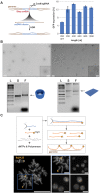Rapid in vitro production of single-stranded DNA
- PMID: 31713635
- PMCID: PMC7145709
- DOI: 10.1093/nar/gkz998
Rapid in vitro production of single-stranded DNA
Abstract
There is increasing demand for single-stranded DNA (ssDNA) of lengths >200 nucleotides (nt) in synthetic biology, biological imaging and bionanotechnology. Existing methods to produce high-purity long ssDNA face limitations in scalability, complexity of protocol steps and/or yield. We present a rapid, high-yielding and user-friendly method for in vitro production of high-purity ssDNA with lengths up to at least seven kilobases. Polymerase chain reaction (PCR) with a forward primer bearing a methanol-responsive polymer generates a tagged amplicon that enables selective precipitation of the modified strand under denaturing conditions. We demonstrate that ssDNA is recoverable in ∼40-50 min (time after PCR) with >70% yield with respect to the input PCR amplicon, or up to 70 pmol per 100 μl PCR reaction. We demonstrate that the recovered ssDNA can be used for CRISPR/Cas9 homology directed repair in human cells, DNA-origami folding and fluorescent in-situ hybridization.
© The Author(s) 2019. Published by Oxford University Press on behalf of Nucleic Acids Research.
Figures


References
-
- Beaucage S., Caruthers M.H.. Deoxynucleoside phosphoramidites—a new class of key intermediates for deoxypolynucleotide synthesis. Tetrahedron Lett. 1981; 22:1859–1862.
-
- Kujau M.J., Wölfl S.. Efficient preparation of single-stranded DNA for in vitro selection. Mol. Biotechnol. 1997; 7:333–335. - PubMed
-
- Bowman B.H., Palumbi S.R.. Zimmer EA, White TJ, Cann RL, Wilson AC. Rapid production of single-stranded sequencing template from amplified DNA using magnetic beads. Methods in Enzymology. 1993; 224:Cambridge: Academic Press; 399–406. - PubMed
Publication types
MeSH terms
Substances
Grants and funding
LinkOut - more resources
Full Text Sources
Other Literature Sources
Research Materials

